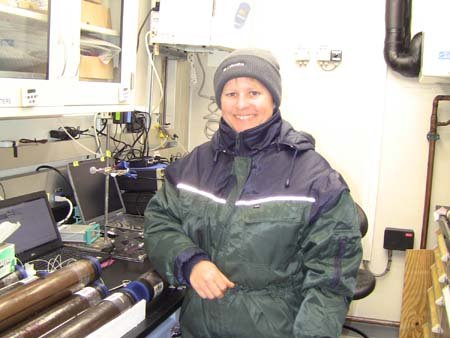
Getting Caught UP
Our four day transit is allowing the ship’s crew to do some minor maintenance work and it is providing time for the scientists to get caught up on some of their work. The microbiologists are taking many samples from each core, so it is easy for them to be overwhelmed by the abundance of material to process. It won’t be long, about 2 days, for cores to be coming on deck and more to analyze. Today, we will take a look at another of the scientists.
Britta Gribsholt is a biochemist chemist participating in Expedition 329.She grew up in Denmark and was always interested in the sea, especially as she lived near the coast. Britta has traveled a lot both for pleasure and for research. She says that she got the travel bug when she was 10 years old; her family drove from Denmark to India where she lived for awhile.In high school, she was an exchange student and spent time in Lancaster, PA.
Britta earned a Masters degree in biology from Aarhus University and a PhD in biogeochemistry from the University of Southern Denmark. Her interest aboard the JOIDES Resolution is in the concentration of oxygen in the deep sediments. Typically near a coastline, there is little oxygen deeper than a few centimeters below the surface because the abundant organisms use it up rapidly. Out in the deep Pacific Ocean where we are currently drilling, there is very little life, so there is nothing to use up the oxygen. Therefore, oxygen should be present in these deeper sediments. That is what Britta came here to find out.
She is using two methods to measure the oxygen in the cores. One involves inserting an electrode into the center of a core to measure oxygen and the other uses an optode to determine oxygen levels. Since these measurements are heavily dependent on temperature, the measurements should be taken immediately, but the cores warm up during the time it takes to bring them to the surface. They change from about 4 degrees C to 12 degrees C during the ascent. The cores are rushed to a refrigerated room where they remain for six hours to stabilize at 10 degrees, the best that can be done under the circumstances. Britta and her co-collaborator, scientist Wiebke Ziebis, must work in a refrigerated room for hours at a time to take the oxygen measurements. This procedure will be followed at each of our drilling sites. She has some long, cold days ahead!
Britta is also collecting samples to aid in other research that she will do back in Denmark. She is interested in bacteria that use ammonia for energy. In her spare time she likes to sea kayak and she is currently fixing up an old farmhouse that she purchased.